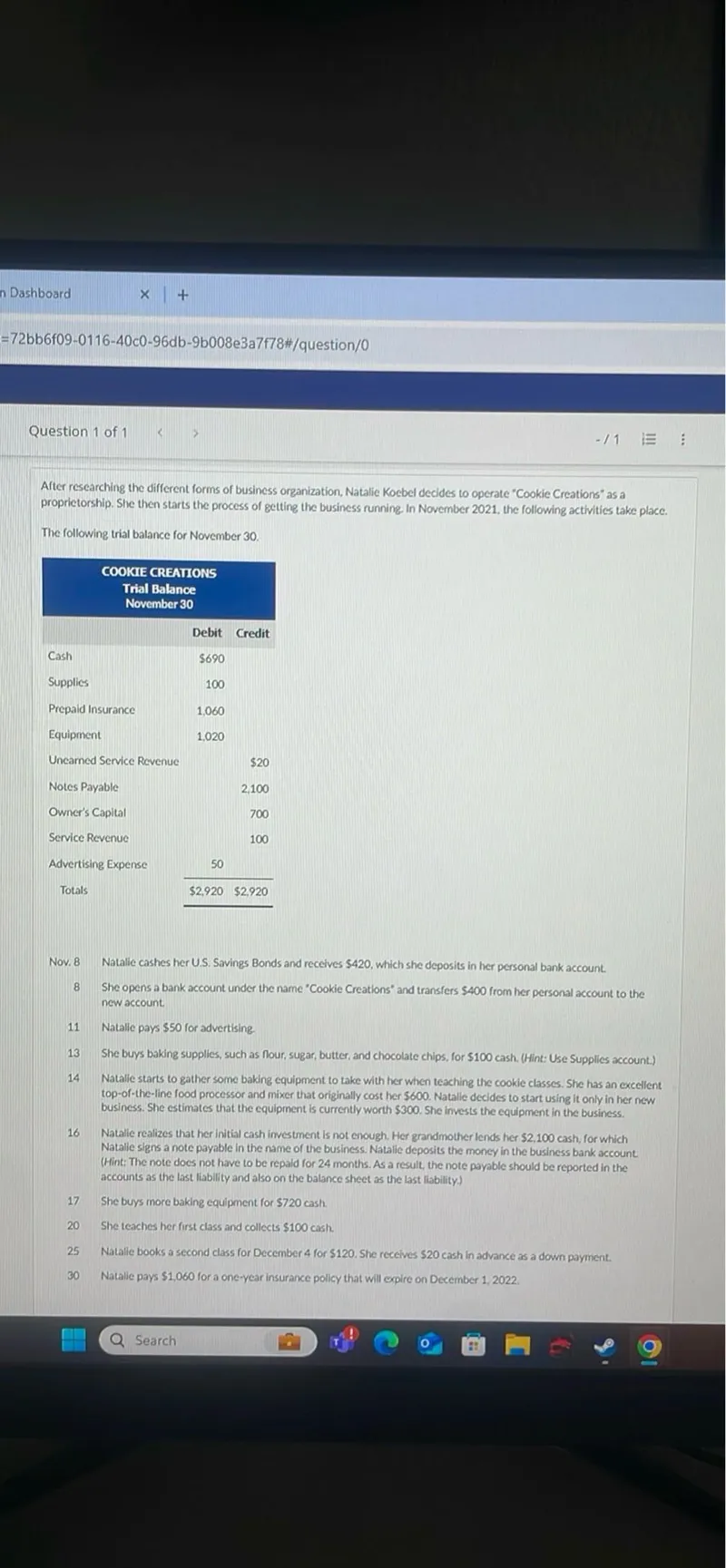Questions: After researching the different forms of business organization, Natalie Koebel decides to operate "Cookie Creations" as a proprietorship. She then starts the process of getting the business running. In November 2021, the following activities take place. The following trial balance for November 30. COOKIE CREATIONS Trial Balance November 30 Debit Credit --------------- Cash 690 Supplies 100 Prepaid Insurance 1,060 Equipment 1,020 Unearned Service Revenue 20 Notes Payable 2,100 Owner's Capital 700 Service Revenue 100 Advertising Expense 50 Totals 2,920 2,920 Nov. 8 Natalie cashes her U.S. Savings Bonds and receives 420, which she deposits in her personal bank account. 8 She opens a bank account under the name "Cookie Creations" and transfers 400 from her personal account to the new account. 11 Natalie pays 50 for advertising. 13 She buys baking supplies, such as flour, sugar, butter, and chocolate chips, for 100 cash. (Hint: Use Supplies account.) 14 Natalie starts to gather some baking equipment to take with her when teaching the cookie classes. She has an excellent top-of-the-line food processor and mixer that originally cost her 600. Natalie decides to start using it only in her new business. She estimates that the equipment is currently worth 300. She invests the equipment in the business. 16 Natalie realizes that her initial cash investment is not enough. Her grandmother lends her 2,100 cash, for which Natalie signs a note payable in the name of the business. Natalie deposits the money in the business bank account (Hint: The note does not have to be repaid for 24 months. As a result, the note payable should be reported in the accounts as the last liability and also on the balance sheet as the last liability.) 17 She buys more baking equipment for 720 cash. 20 She teaches her first class and collects 100 cash. 25 Natalie books a second class for December 4 for 120. She receives 20 cash in advance as a down payment. 30 Natalie pays 1,060 for a one-year insurance policy that will expire on December 1, 2022.

Transcript text: After researching the different forms of business organization, Natalie Koebel decides to operate "Cookie Creations" as a proprietorship. She then starts the process of getting the business running. In November 2021, the following activities take place.
The following trial balance for November 30.
COOKIE CREATIONS
Trial Balance November 30
| Debit | Credit |
|-------|--------|
| Cash | $690 | |
| Supplies | 100 | |
| Prepaid Insurance | 1,060 | |
| Equipment | 1,020 | |
| Unearned Service Revenue | | $20 |
| Notes Payable | | 2,100 |
| Owner's Capital | | 700 |
| Service Revenue | | 100 |
| Advertising Expense | 50 | |
| Totals | $2,920 | $2,920 |
Nov. 8 Natalie cashes her U.S. Savings Bonds and receives $420, which she deposits in her personal bank account.
8 She opens a bank account under the name "Cookie Creations" and transfers $400 from her personal account to the new account.
11 Natalie pays $50 for advertising.
13 She buys baking supplies, such as flour, sugar, butter, and chocolate chips, for $100 cash. (Hint: Use Supplies account.)
14 Natalie starts to gather some baking equipment to take with her when teaching the cookie classes. She has an excellent top-of-the-line food processor and mixer that originally cost her $600. Natalie decides to start using it only in her new business. She estimates that the equipment is currently worth $300. She invests the equipment in the business.
16 Natalie realizes that her initial cash investment is not enough. Her grandmother lends her $2,100 cash, for which Natalie signs a note payable in the name of the business. Natalie deposits the money in the business bank account (Hint: The note does not have to be repaid for 24 months. As a result, the note payable should be reported in the accounts as the last liability and also on the balance sheet as the last liability.)
17 She buys more baking equipment for $720 cash.
20 She teaches her first class and collects $100 cash.
25 Natalie books a second class for December 4 for $120. She receives $20 cash in advance as a down payment.
30 Natalie pays $1,060 for a one-year insurance policy that will expire on December 1, 2022.





